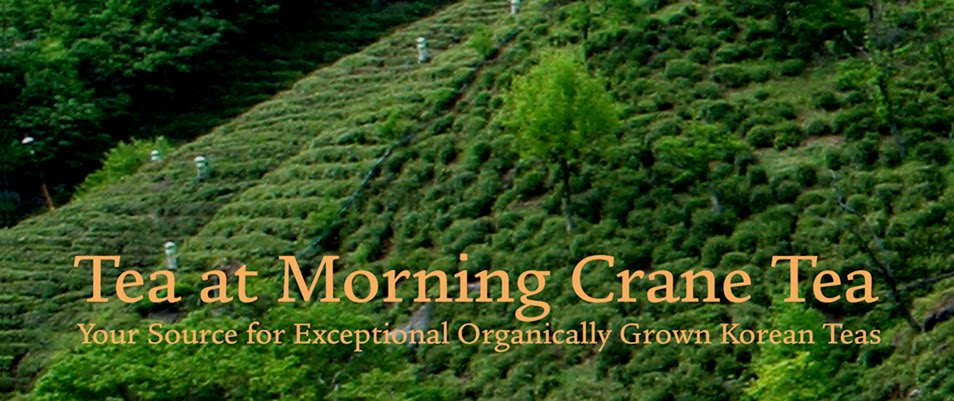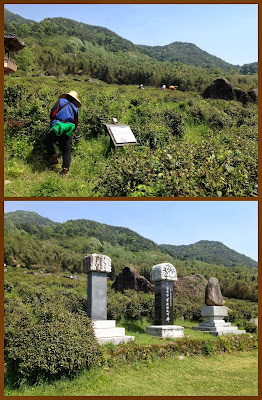This post has been long in coming. I should have posted it in the Spring. For those across the changing climate in the northern hemisphere around the world we are in ‘balhyocha’ time for teas. But most of my retail customers are from the West Coast and Southwestern USA, Australia and other warmer climates so for them nokcha is always in season. Besides a good green tea is good anytime of year anywhere you live.
This year I am able to offer some great new teas, but I've had very little time to tell you about them.
Because the delicious Dong Cheon semi-wild organic teas from Jerisan are our standard, I want to tell you about one of their new teas that is in concept and flavor for me one of the most interesting teas we have ever offered. It is called 無爲 Mu-Wi Sejak (Mu-Wee).
I am far from a Taoist scholar, Seon Priest or even ruminant scholar but I am slightly familiar with two concepts of ‘mu’ that are important to these philosophies/religions. They are mu-shim and mu-wi. Like most rather deep Asian religious and meditative concepts, they are difficult to explain in English. If I were a true Taoist or Seon scholar my guess is I would not be so foolish to try to explain them at all, especially not on a blog post. But since I am not any of those and hopefully this post won’t (certainly shouldn't) end up in anyone's dissertation . . ..
Lets begin with the term ‘mu-shim’. It is actually a rather well known term even in the West, but perhaps not in this form. The term ‘mu’ means something like ‘empty’, ‘nothing’, ‘nothingness’ or ‘without‘ etc. The term ‘shim‘, as in ‘mu-shim', is loosely translated as ‘mind’ as in the ‘conscious mind’ or the ‘unconscious mind’. The term ‘mu-shim‘ is therefore translated as ‘empty mind’. It is not the unconscious mind. In practice it means being in a state where the mind transcends ‘thought’ to simply be able to act without “thinking” or the interference of ‘thought’. It implies being without all those thoughts that can interfere with ones ability to act or do. To essentially be ‘one’ with the moment without thinking about it. It should be a very natural, unagitated and a peaceful state of being. It is the state I attempt to approach when I meditate before forming a chawan or even a simple teacup. Essentially I try to rid my mind of all the mental ‘debris’ of ‘knowledge’ or what may be bothering me that day and simply ‘do’. When the process is successful that chawan or teacup is often ‘better than I can ‘do’ especially if the glaze and kiln do their part.
But what about ‘mu-wi’? Basically, the term means ‘doing nothing’. It is not the lazy and slothful ‘doing nothing’, but like mu-shim the peaceful ‘doing nothing’ and the relaxing ‘doing nothing’, the vacation ‘doing nothing’ or in our case the Tea meditation ‘doing nothing’.
Enough savoring of the word, It is time to savor the tea - and it is indeed a tea worthy of savoring.
But what about ‘mu-wi’? Basically, the term means ‘doing nothing’. It is not the lazy and slothful ‘doing nothing’, but like mu-shim the peaceful ‘doing nothing’ and the relaxing ‘doing nothing’, the vacation ‘doing nothing’ or in our case the Tea meditation ‘doing nothing’.
Enough savoring of the word, It is time to savor the tea - and it is indeed a tea worthy of savoring.
I first tried this tea served by Ha Ilnam owner of Dong Cheon tea company in his famous tea shop in Insadong Korea. Mary, my wife, and I were with a friend who owns a teashop in Berlin, Germany. My friend’s response after tasting this tea was to order 7.5 kilo.
True, Ha Ilnam is a master brewer. I was once with a tea connoisseur, who after witnessing Mr. Ha brew several teas, said to me, “He is so good at brewing he could make Daejak taste like Woojeon.”
But I’m not a master brewer and this tea tastes great when I brew it too.
Now to the description of my first at home impression of the tea Mu-Wi Sejak. As with all the teas I encounter, my first impression is with the nose when in this case the 250g bag was first opened*. That is one of the benefits of having a tea business. I’m able to open larger bags of tea and experience their full aroma. With this Mu-wi Sejak, I catch the essence of this tea - a roasty fragrance that simply grasps me gently and pulls me in.
I resist, to avoid contamination, and reach for a cup then scoop in some tea leaves. Now I can fully explore its depth as I bring the leaf filled cup to my nose and breath it in - in an out - taking a long moment just to enjoy this delightful, sweet, mildly roasted bouquet, “Whoa!” I quietly exclaim, “This is going to be good.”
The leaves are tiny. I select one, place it on my tongue and chew. The dry crispy flakey leaf crumbles, then gives way to a sweet very slightly bitter and slightly nutty taste. I take a few more leaves and discover I could sit here and simply eat this tea like a snack.
But this tea is for brewing and I must see how it responds to the water I’m using here in the USA.
I have become quite sensitive to the affects of water on tea. Our family home in PA has terrible town supplied well water that is supposed to be acceptable to consume but in reality is not drunk from the tap by anyone. It certainly can’t be used for tea. Water has a profound effect on the taste of tea. Fortunately where we live the water is excellent. We brew our teas with filtered tap water that has been quickly boiled to remove any faint traces of chlorine - but not boiled to death. I have tried various bottled spring waters but have come to prefer this tap water. How fortunate.
I usually use a Park Jong Il teapot and cups but I want you to see how the leaves and color develop so I’ll use a small glass teapot with a Park Jong Il cup.
I weigh out 3g of tea leaves for this 150 ml (5oz) teapot. After warming the pot and cups I pour in the dry leaves and a ‘splash’ of the hot water to waken the leaves. I must enjoy the essence of this now hot and wet tea once more with my nose. The ambrosial juices are released.
The teapot is filled with water that was heated to about 145F or about 63C. This tea will stand more heat but I prefer these lower temperatures for delicate green teas. Brewing time is 35-50 seconds for first brew. It pours into my cup a sweet, fresh slightly savory, roasty and lightly slippery tea that coats my mouth - delicious. I am not one to describe taste well but I like what I am tasting and believe you will too.
As a side note, I never rinse or wash any of my Korean tea leaves to get rid of dust or fannings not even our balhyochas. They don’t need it.
The tea is delicious smooth gentle and savory more roasty than I expected but not a robust flavor. That will come with the larger tea leaves. Still delicious and it seems to live up to its name. For I'm able to relax and simply enjoy the moment.
Check out these Mu-wi leaves after brewing. Maybe I should pickle them or use them in a pajeon Korean pancake.
I obviously didn’t write this post to make a lot of money selling this tea (I might have two bags left) but rather I wanted to introduce you to a tea you might not be familiar with. Mu-wi like Gok-woo green teas are seldom made. This is a special tea with a special price list $28.00 price $23.00 50g if we have any left.
The cup is a Park Jong Il white teacup. We will be having a sale on his tea ware soon on what we have in stock. Those sale prices are available to you now. Contact me for the tea ware and green tea sale.
The Park Jong Il tea set I would have used.
Note: Green Tea Sale 50g silver bags
Woojeon: List $48.00 Sale $46.00
Mu-wi Sejak: List $28.00 Sale $25.00
Sejak: List $25.00 Sale $20.50
Jungjak: List $18.00 Sale $15.50
Daejak: List $15.00 Sale $12.50
Yip-Cha List $ 8.00 Sale $ 6.00
Contact us to see if we have anything left.
The Woojeon is the good stuff and sells at $50.00 in Korea.
The Mu-wi you now know. The Sejak is wonderful and has been blogged about by others. Some say this is the best year for Jungjak and the Daejak is a wonderful tea at an excellent price. Yip-cha as a wonderful everyday green tea from the same semi-wild organic plants as all of our Dong Cheon teas. It is a favorite everyday tea in Insadong.
But we are getting low on our greens so if you are interested act. The price goes up Nov.1 and we could run out of tea before then.
If orders are placed by Oct 25, 2013 I will order any of these teas for you at these prices.
Will I reorder more of these greens before spring after Nov. 1? I'm not sure. That depends on this sale.
These prices are good for what I have in stock, which isn’t much, and for orders placed before Oct. 25.
Don't get spooked but the sale ends on Halloween October 31, 2013. Place your green tea order now.
Did you miss the posts on Picking Tea in Korea? Click here.
Balhyochas coming soon.
Did you see the Park Jong Il teapot sale? Chick here.































